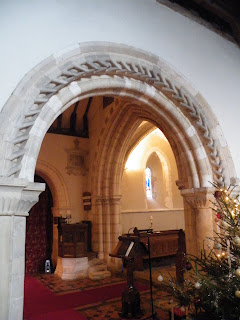 Burpham church looks plain and matter-of-fact from the outside. You have to step inside to discover what a complex and lovely building it is.
Burpham church looks plain and matter-of-fact from the outside. You have to step inside to discover what a complex and lovely building it is. The church was originally a plain Norman cross-shaped church that was altered and extended
The church was originally a plain Norman cross-shaped church that was altered and extended  over the course of the 12th century. Today it presents a text-book illustration of the change from round to pointed arches.
over the course of the 12th century. Today it presents a text-book illustration of the change from round to pointed arches.The arch to the north transept (in the background of the picture on the right) is the oldest, dating to before 1150. It is little more than a semicircular opening in the wall.
The south transept arch was built in about 1160 and is much more ornate. Three attached columns on either side support the arch, with deep cut zigzag and chevron ornament. It is so lavish it may have been the entrance to a lost chapel or tower.
 It was at this point the pointed arch arrived in Sussex. Pointed arches had been invented in the early part of the century and used at Durham Cathedral in 1130, but it took until the end of the century to spread round the country.
It was at this point the pointed arch arrived in Sussex. Pointed arches had been invented in the early part of the century and used at Durham Cathedral in 1130, but it took until the end of the century to spread round the country.The chancel at Burpham was rebuilt shortly after 1180 with a lovely rib-vaulted roof that demonstrates exactly why pointed arches were useful. Round arches can be used in vaulting, but the diagonal arches rise higher than the arches on the sides so the vaulting goes up and down like the Loch Ness monster’s humps.
Pointed arches can be easily designed to rise to the same height, giving a straight ridge.
 The vaulting at Burpham shows how lovely the effect can be: subtle but simple and strong.
The vaulting at Burpham shows how lovely the effect can be: subtle but simple and strong.Beware the chancel arch, however. In 1869 the original Norman arch became unstable and was replaced with the current Early English style arch by the architect Sir Thomas Jackson. Jackson was one of those rare architects who produced original and characteristic work when designing from scratch, but hauled in his ego and respected the fabric when restoring and altering existing buildings. He also almost invisibly rebuilt the south wall of the church.
 The illustrator and author Mervyn Peake lived in Burpham and is buried in the churchyard. The view of Arundel Castle across the valley may have influenced his vision of the mighty fortress of Gormenghast.
The illustrator and author Mervyn Peake lived in Burpham and is buried in the churchyard. The view of Arundel Castle across the valley may have influenced his vision of the mighty fortress of Gormenghast.